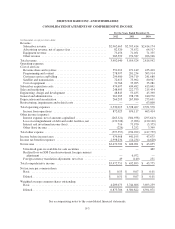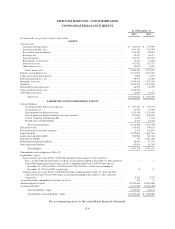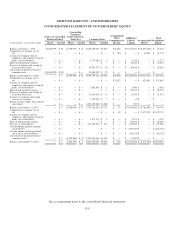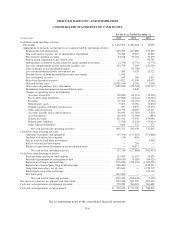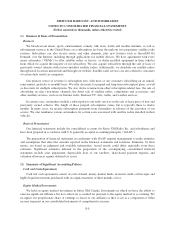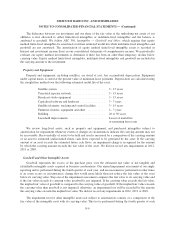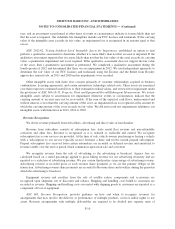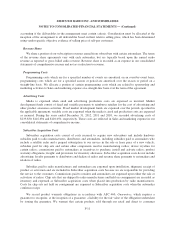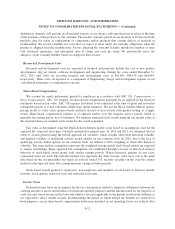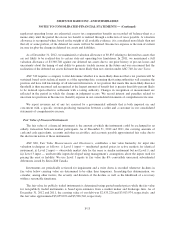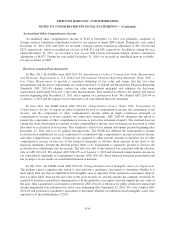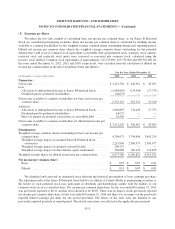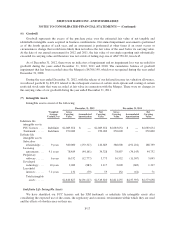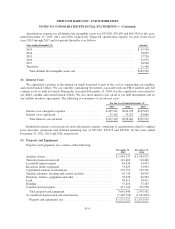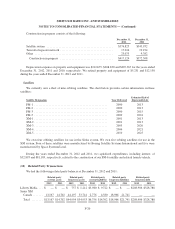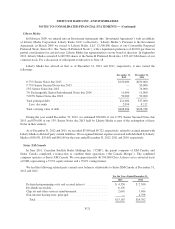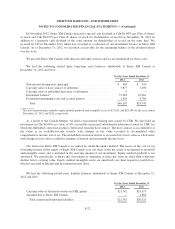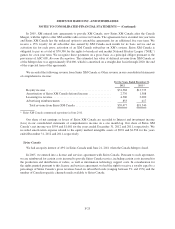XM Radio 2012 Annual Report Download - page 99
Download and view the complete annual report
Please find page 99 of the 2012 XM Radio annual report below. You can navigate through the pages in the report by either clicking on the pages listed below, or by using the keyword search tool below to find specific information within the annual report.SIRIUS XM RADIO INC. AND SUBSIDIARIES
NOTES TO CONSOLIDATED FINANCIAL STATEMENTS — (Continued)
regular net operating losses are exhausted; excess tax compensation benefits are recorded off balance-sheet as a
memo entry until the period the excess tax benefit is realized through a reduction of taxes payable. A valuation
allowance is recognized when, based on the weight of all available evidence, it is considered more likely than not
that all, or some portion, of the deferred tax assets will not be realized. Income tax expense is the sum of current
income tax plus the change in deferred tax assets and liabilities.
As of December 31, 2012, we maintained a valuation allowance of $9,835 relating to deferred tax assets that
are not likely to be realized due to certain state net operating loss limitations. In 2011, we maintained a full
valuation allowance of $3,360,740 against our deferred tax assets due to our prior history of pre-tax losses and
uncertainty about the timing of and ability to generate taxable income in the future and our assessment that the
realization of the deferred tax assets did meet the more likely than not criterion under ASC 740, Income Taxes.
ASC 740 requires a company to first determine whether it is more-likely-than-not that a tax position will be
sustained based on its technical merits as of the reporting date, assuming that taxing authorities will examine the
position and have full knowledge of all relevant information. A tax position that meets this more-likely-than-not
threshold is then measured and recognized at the largest amount of benefit that is greater than fifty percent likely
to be realized upon effective settlement with a taxing authority. Changes in recognition or measurement are
reflected in the period in which the change in judgment occurs. We record interest and penalties related to
uncertain tax positions in Income tax (benefit) expense in our consolidated statements of comprehensive income.
We report revenues net of any tax assessed by a governmental authority that is both imposed on, and
concurrent with, a specific revenue-producing transaction between a seller and a customer in our consolidated
statements of comprehensive income.
Fair Value of Financial Instruments
The fair value of a financial instrument is the amount at which the instrument could be exchanged in an
orderly transaction between market participants. As of December 31, 2012 and 2011, the carrying amounts of
cash and cash equivalents, accounts and other receivables, and accounts payable approximated fair value due to
the short-term nature of these instruments.
ASC 820, Fair Value Measurements and Disclosures, establishes a fair value hierarchy for input into
valuation techniques as follows: i) Level 1 input — unadjusted quoted prices in active markets for identical
instrument; ii) Level 2 input — observable market data for the same or similar instrument but not Level 1; and
iii) Level 3 input — unobservable inputs developed using management’s assumptions about the inputs used for
pricing the asset or liability. We use Level 3 inputs to fair value the 8% convertible unsecured subordinated
debentures issued by Sirius XM Canada.
Investments are periodically reviewed for impairment and a write down is recorded whenever declines in
fair value below carrying value are determined to be other than temporary. In making this determination, we
consider, among other factors, the severity and duration of the decline as well as the likelihood of a recovery
within a reasonable timeframe.
The fair value for publicly traded instruments is determined using quoted market prices while the fair value
for non-publicly traded instruments is based upon estimates from a market maker and brokerage firm. As of
December 31, 2012 and 2011, the carrying value of our debt was $2,435,220 and $3,013,974, respectively; and
the fair value approximated $3,055,076 and $3,506,546, respectively.
F-13


